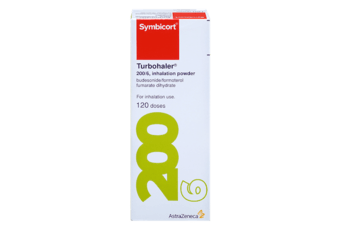Medication features
Symbicort Turbohaler is a combination treatment that is used to treat respiratory diseases such as asthma. Symbicort is used to open up the airways for easier breathing and reduce inflammation of the lungs. Used for the relief and prevention of asthma attacks, Symbicort treats respiratory diseases with its two active ingredients; budesonide and formoterol.
- Reduces swelling and inflammation in the airways
- Budesonide and Formoterol
- Genuine medication
- All drugs sourced in the UK
Overview
What Is Symbicort Turbohaler?
Symbicort Turbohaler is an inhaler that is used to prevent symptoms of asthma, a common lung condition that affects more than five million people in the UK, and chronic obstructive pulmonary disease (COPD), a group of lung conditions which affects over one million Brits. It is a corticosteroid preventative inhaler which not only prevents your asthma symptoms but can also prevent future attacks.
This inhaler contains two active ingredients; budesonide, belonging to the corticosteroid class of medications which can reduce inflammation in your airways; and formoterol fumarate dihydrate, which is a long-acting beta 2 agonist that helps to open up your airways.
Symbicort Turbohaler is available in three strengths:
- Symbicort Turbohaler 100 – containing 100mcg budesonide and 6mcg formoterol fumarate
- Symbicort Turbohaler 200 – containing 200mcg budesonide and 6mcg formoterol fumarate
- Symbicort Turbohaler 400 – containing 400mcg budesonide and 12mcg formoterol fumarate
What Is Symbicort Used For?
Symbicort Turbohaler is an everyday inhaler used to prevent asthma symptoms – both to control asthma symptoms and prevent future attacks. As well as treating asthma symptoms, Symbicort Turbohalers are used by people with COPD to improve their lung function.
You may be prescribed Symbicort Turbohaler along with a Ventolin reliever inhaler; using the Symbicort Turbohaler every day to help prevent asthma symptoms, and your reliever inhaler to ease asthma symptoms when they do occur. Or, you may be prescribed Symbicort Turbohaler as your only asthma inhaler.
How Does Symbicort Work?
Symbicort Turbohaler’s two active ingredients combine to help prevent asthma symptoms. Budesonide, the corticosteroid, works by reducing irritation and inflammation in the lungs and preventing cells in the lungs and airways from releasing certain substances that cause asthma symptoms. Formoterol fumarate dihydrate, Symbicort Turbohaler’s other active ingredient, relaxes the muscles in your airways, opening up your breathing passages.
Symbicort and Pregnancy
Using Symbicort Turbohaler is only recommended in pregnancy if the benefit outweighs the risk. If you are pregnant or are planning to get pregnant, you should talk to your doctor. You shouldn’t stop using Symbicort Turbohaler if you have become pregnant - but talk to your doctor as soon as possible; they will be able to advise you on whether to continue using it.
If you are breastfeeding, you should talk to your doctor before using Symbicort Turbohaler. Should your doctor advise that you can’t use Symbicort Turbohaler while pregnant and/or breastfeeding, you should stop the medication immediately. Other asthma inhalers – such as levalbuterol, salbutamol and pirbuterol - may provide safe alternatives to Symbicort Turbohaler. You should always consult with your doctor before starting a new medication.
Symbicort vs Seretide
Like Symbicort Turbohaler, Seretide is a combination inhaler. Seretide has different active ingredients to Symbicort Turbohaler – rather than budesonide and formoterol fumarate dihydrate, Seretide contains fluticasone and salmeterol. Fluticasone, a corticosteroid, is similar to budesonide, making breathing easier and reducing inflammation in the airways. Like the formoterol fumarate dihydrate in Symbicort Turbohaler, salmeterol is a long-acting beta 2 agonist that relaxes the muscles in your lungs and airways.
A study compared the effectiveness of using Seretide and a separate reliever to budesonide and formoterol (Symbicort Turbohaler’s active ingredients). It was found that compared to using Seretide and a separate reliever, patients that used budesonide and formoterol for maintenance and as a preventer reduced their risk of a severe asthma attack by 25%.
Symbicort Turbohaler is used in a similar way to Seretide. Dosage varies according to the severity of your asthma, and the two inhalers share some of the same potential side effects, including headache and throat irritation.
Fostair vs Symbicort
Fostair is another combination inhaler for asthma and COPD. It can both prevent and control symptoms such as wheezing and breathlessness. Both Fostair and Symbicort Turbohaler contain formoterol, the long-acting beta 2 agonist that provides muscle relaxation in your airways to make breathing easier. Fostair also contains beclometasone dipropionate (a corticosteroid in the same class of medication of drugs that budesonide in Symbicort Turbohaler belongs to), which reduces inflammation and relieves lung irritation.
Fostair is used like the Symbicort Turbohaler. Your dosage will depend on the severity of your condition, and if you are using the device as both a preventer inhaler and reliever inhaler, or just as a preventer inhaler. Fostair and Symbicort Turbohaler share potential side effects such as sore throat and headache.
Symbicort vs Ventolin
Symbicort Turbohaler and Ventolin (the branded version of the generic salbutamol) are both inhalers for asthma or COPD, but they are used in different ways. While Symbicort Turbohaler is a daily-use inhaler that is used to prevent and control symptoms of asthma and COPD, Ventolin is a reliever inhaler that is used to provide rapid relief from asthma and COPD symptoms. When asthma or COPD symptoms occur, Ventolin relaxes the muscle bands in the airways and makes breathing easier.
Ventolin dosage will vary according to your individual needs. The inhaler shares some potential side effects with Symbicort Turbohaler – such as headache and throat irritation – and can also cause jitters or shaking in the minutes after you use it.
Symbicort Turbohaler Reviews
Both asthma and COPD sufferers have given Symbicort Turbohaler positive reviews online. Some were prescribed the inhaler after alternatives such as salbutamol and mometasone had been ineffective. Users reported an immediate improvement in their breathing after starting to use Symbicort Turbohaler, while others noticed that their breathing had become easier within a week or so.
Reviewers online have commented how, thanks to its ability to control and prevent asthma symptoms, Symbicort Turbohaler has helped them to get on with everyday life. Others highlighted the extent to which the inhaler has reduced their asthma or COPD symptoms after starting to use it. Side effects cited include an unpleasant taste in the mouth, throat irritation and headache.
Can You Buy Symbicort Turbohaler Over the Counter?
You will only be able to buy Symbicort Turbohaler in the UK with a prescription. You cannot purchase Symbicort Turbohaler over the counter. Before you can be issued a prescription for the inhaler, a prescriber will need to assess your suitability.
You could save time by buying Symbicort Turbohaler online at Cloud Pharmacy. After having an online consultation for Symbicort Turbohaler, your prescription needs to be approved by one of our online pharmacists. Once your prescription has been issued, we will then send the inhaler to your address via our next-day delivery service.
Directions
How Long Does Symbicort Take To Work?
You can expect your Symbicort Turbohaler to take effect in no more than two weeks. The formoterol fumarate dihydrate - which opens up your airways to make breathing easier – typically takes a few days to provide relief, and while budesonide may take a little longer to begin reducing inflammation noticeably, you should be able to feel a difference within two weeks.
How to Use Symbicort Turbohaler
You will use your Symbicort Turbohaler twice a day as a preventer. Continue using Symbicort Turbohaler even if you don’t have any breathing problems, as if you stop using the inhaler, breathing issues could return. How many puffs you take each time you use Symbicort Turbohaler will vary according to the severity of your condition, and if you are using the device as only a preventer inhaler (maintenance therapy) or for a preventer and reliever inhaler.
Symbicort Turbohaler delivers a fine mist into your mouth, which you inhale into your lungs. Press down the canister at the same time as you inhale. If this is hard to coordinate, your doctor or pharmacist can recommend a spacer, which can make it easier to press and inhale together.
Rinse your mouth out after using Symbicort Turbohaler to help prevent developing a fungal infection. If you miss a dose, take it when you remember, unless it is nearly time for the next dose. In that case, skip the missed dose and take the next dose at the normal time.
For further advice on how to use Symbicort Turbohaler, ask your pharmacist or doctor, and refer to your patient information leaflet.
Side Effects
Side Effects of Symbicort
Some people don’t experience any side effects from Symbicort Turbohaler. However, potential side effects may include:
- Fungal infection in the mouth or throat
- Headache
- Sore throat
- Trembling or jitters
- Heart palpitations
- Coughing
If you experience any serious side effects such as:
- Chest pain
- A fast and irregular heartbeat
Contact a medical professional or call 999 immediately.
Patient Information Leaflet
Symbicort Turbohaler Patient Information Leaflet
For more information about Symbicort Turbohaler, take a look at the patient information leaflet below:
Symbicort Turbohaler Reviews
Confirm Symbicort Turbohaler treatment selection
| 100/6 | 1 | £45.99 |
| 200/6 | 1 | £45.99 |
| 400/12 | 1 | £45.99 |
















